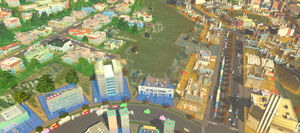
Zoning in city:skylines
Demand[]
The Residential, Commercial and Industrial (RCI) meter is NOT a demand meter for more of each zone type. It is a common misconseption to think it refers to zone demand. In fact, it represents the following:
- Green indicates demand for workers
- Blue indicates ratio of commercial workers to total citizen population, as well as ratio of unused visitor spaces to total visitor spaces.
- Yellow indicates unemployment percentage
The RCI meter can be viewed in the user interface. The value of each RCI meter extends from -50 to +50. A perfectly balanced city will have each RCI meter filled half way to a value of 0. However, you may need to upset the balance to grow a city.
The RCI meter will change in value according to the following rules:
- Residential (Green) - this meter reflects the demand for workers from all Commercial, Industrial and Office zones or buildings. This includes worker demand from Industrial Buildings in the Cities Skylines: Industries and other game expansions. A high meter indicates lots of demand for new workers, while a low meter suggests that there is an oversupply of workers. A 50% full meter indicates a good balance of workers to jobs available. [1]
- Commercial (Blue) - this meter follows a more complex formula. The first part of the formula deals with the ratio of commercial workers to total citizen population. The ideal balance is to achieve a ratio of 1 commercial worker (a citizen that works in a commercial building) to 8 citizens. For example, a city of 80,000 population should have 10,000 commercial workers. The second part of the formula deals with availability of visitor slots. The perfect balance for this part of the forumula is to achieve 1:3 of empty visitor slots to occupied visitor slots. Visitor slots are created by commercial buildings, parks and leisure buildings, and some monuments. Visitor slots are filled when citizens or tourists visits one of these building types. [2]
- Industrial (Yellow) - this meter is filled or reduced depending on how high or low unemployment in a city is. High unemployment will fill the meter, while low unemployment reduces the meter. A meter filled to the optimal 50% is achieved with unemployment at 5%. [3]
In other words:
High demand for labour → Residential demand.
High supply of citizens → Commercial demand.
Low supply of labour → Industrial demand.
Zones[]
Residential
Commercial
Industrial
Trivia[]
Concept[]
The concept behind zoning versus individual placement was discussed during development. During development, the developers have clearly planned the idea of zoning rather than individual placement as it was believed that individual placement would turn the game into an editor rather than a city builder. It was also impractical of communicating constantly game-changing information in a sense of the artistic talent of the player, for example, to place ten tenements when the game only required three. Eventually, as the game progresses to more technological levels, the player would have to manually upgrade each and every of the thousands of placed buildings.
As a result of the thought experiment, the idea of zoning came to light to simulate closely to city-planning by establishing guidelines for the citizens and companies to work in. Players could take advantage of the grid system and have more control over the zoning area.[4]
References[]
- ↑ https://forum.paradoxplaza.com/forum/threads/how-to-get-residential-demand.865600/#:~:text=Residential%20demand%20is%20demand%20by,satisfy%20the%20demand%20for%20workers.
- ↑ https://forum.paradoxplaza.com/forum/threads/no-commercial-demand.842310/page-4#post-19033793
- ↑ https://steamcommunity.com/sharedfiles/filedetails/?id=2280803540
- ↑ "Cities: Skylines - Dev Diary 2: Zoning". Paradox Interactive. 7 October 2014.
